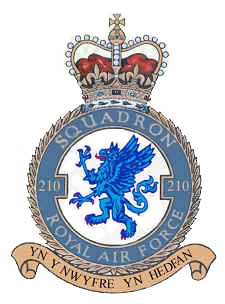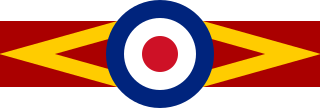
No. 206 Squadron is a Test and Evaluation Squadron of the Royal Air Force. Until 2005 it was employed in the maritime patrol role with the Nimrod MR.2 at RAF Kinloss, Moray. It was announced in December 2004 that 206 Squadron would disband on 1 April 2005, with half of its crews being redistributed to Nos. 120 and 201 Squadrons, also stationed at Kinloss. This was a part of the UK Defence Review called Delivering Security in a Changing World; the Nimrod MR.2 fleet was reduced in number from 21 to 16 as a consequence.

No. 78 Squadron of the Royal Air Force operated the Merlin HC3/3A transport helicopter from RAF Benson. Until December 2007 it was the operator of two Westland Sea King HAR3s from RAF Mount Pleasant, Falkland Islands.

No. 43 Squadron was a Royal Air Force aircraft squadron originally formed in 1916 as part of the Royal Flying Corps. It saw distinguished service during two world wars, producing numerous "aces". The squadron last operated the Panavia Tornado F3 from RAF Leuchars, Scotland, in the air defence role, until it was disbanded in July 2009.

No. 220 Squadron of the Royal Air Force (RAF) was founded in 1918 and disbanded in 1963 after four separate periods of service. The squadron saw service in both the First and Second World Wars, as a maritime patrol unit, and finally as part of Britain's strategic nuclear deterrent.
No. 90 Squadron RAF is a squadron of the Royal Air Force.

No. 253 (Hyderabad) Squadron was a flying squadron of the Royal Air Force between 1918 and 1947. Originally formed in 1918, it served in WW1 flying coastal reconnaissance and anti-submarine patrols. Later in WW2 it took part in the Battle of France, the Battle of Britain, and then fought in the Mediterranean Theatre of Operations in Algeria. The squadron was disbanded on 16 May 1947, and briefly revived as a night-fighter squadron from 18 April 1955 to 2 September 1957.
No. 61 Squadron was a squadron of the Royal Air Force. It was first formed as a fighter squadron of the British Royal Flying Corps during the First World War. It was reformed in 1937 as a bomber squadron of the Royal Air Force and served in the Second World War and after, until disbanded in 1958.
No. 53 Squadron was a Royal Air Force squadron that saw service in both the First and Second World Wars.

No. 112 Squadron was a squadron of the Royal Air Force. It served in both the First World War and Second World War and was active for three periods during the Cold War. It is nicknamed "The Shark Squadron", an allusion to the fact that it was the first unit from any Allied air force to use the famous "shark mouth" logo on Curtiss P-40s.

No. 210 Squadron was a Royal Air Force unit established in World War I. Disbanded and reformed a number of times in the ensuing years, it operated as a fighter squadron during World War I and as a maritime patrol squadron during the Spanish Civil War, World War II and the Cold War before it was last deactivated in 1971.
No. 59 Squadron was a squadron of the Royal Air Force.

No. 79 Squadron was a squadron of the Royal Air Force.

No. 80 Squadron RAF was a Royal Flying Corps and Royal Air Force squadron active from 1917 until 1969. It was operative during both World War I and World War II.
No. 219 Squadron of the Royal Air Force was founded in 1918 and disbanded in 1957 after four separate periods of service. During the First World War it served as a coastal defence unit, and through most of the Second World War and the 1950s it operated as a night fighter air defence squadron. Three commanders of the squadron went on to be Chiefs of the Air Staff, two of the RAF and one of the Royal Pakistani Air Force.
No. 126 Squadron RAF was a Royal Air Force Squadron formed to be a day bomber unit in World War I and reformed as a fighter unit in World War II.
No. 128 Squadron RAF was a Royal Air Force Squadron formed to be a day bomber unit in World War I and reformed as a fighter unit in World War II.
No. 131 Squadron RAF was a Royal Air Force Squadron formed to be a bomber unit in World War I and reformed as a fighter unit in World War II.
No. 188 Squadron RAF was a Royal Flying Corps and Royal Air Force Squadron that was a night training unit towards the end of World War I.
No. 252 Squadron RAF was a Royal Air Force (RAF) squadron that formed as a bomber unit in World War I and re-formed as part of RAF Coastal Command in World War II.
No. 272 Squadron RAF was a Royal Air Force Squadron formed as an anti–submarine unit in World War I and a coastal fighter unit in World War II.










